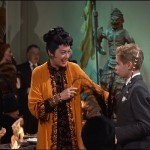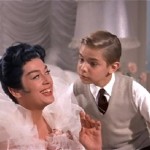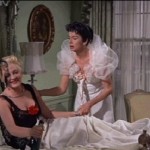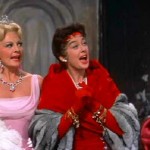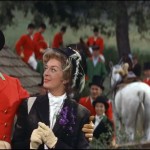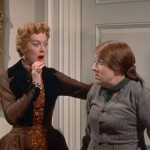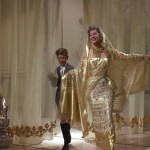
Auntie Mame – 1958
Rosalind Russell was fantastic as the title role of Auntie Mame. She was over-the-top and dramatic, which is what the role demanded. As a matter of fact, her flamboyant personality was the plot point that drove most of the story. The essence of the film is actually an easy one to sum up in just a few sentences. The character’s motto was that “Life is a banquet, and most poor suckers are starving to death.” Mame didn’t intend to miss a single bite.
The plot is also fairly simple. Young Patrick, played by Jan Handzlik, comes to live with his Auntie Mame, a wealthy socialite, after the death of his father. Growing up in Mame’s New York house, which seems to be party central, Patrick has an unusual and fabulous childhood. When Mame falls on hard times, the love that they share sustains them until Mame marries into money. While Mame and her husband travel the world, Patrick, played as an adult by Roger Smith, grows up in danger of turning into the kind of uptight square that Mame detests. There is a hilarious scene in which Mame gets rid of the snobbish family of the girl Patrick is expected to marry. The two reaffirm their love for each other and give us our happy ending.
The story is actually pretty original and the relationship between Patrick and his Auntie Mame is a simple one. The two adore each other. No matter what changes life throws at them, their love is a constant that never wavers. Now, that being said, one of the things I loved most about the film was the ever changing set that was Mame’s home. The décor seemed to change with Mame’s ever shifting moods.
The first time we see her home, it is furnished with a Chinese motif that is loud, shocking, and bordering on gaudy, but never crossing the line into bad taste. It is bold and striking, and yet chic and fashionable. The front door portraying a gold Chinese dragon that spouted smoke whenever the doorbell was rung was a bit much, but that was more for comedic effect.
Next we saw a minimalistic apartment that had plenty of open space and clean lines. The walls were white with strategically placed curtains and sculptures. The furniture was bare and unornamented. It was beautiful. Several more changes happened throughout the course of the film until it finally settled on an Indian motif with murals of misty jungles and statues or panthers as accents.
The Art Director and the Set Decorator, Malcolm Bert and George James Hopkins, respectively, really had their work cut out for them and they came through with flying colors. They were nominated for Academy Awards in Art Design, but unfortunately lost those honors to Gigi. Listen, I’ve seen Gigi, and I can say with confidence, Auntie Mame got robbed. And I would be remiss if I didn’t mention the incredible and glamorous costumes. Perfection!
The entire cast did a fantastic job, but I need to mention a few that stood out to me as particularly good. Keeping in mind that the movie was a comedy, Mame’s best friend Vera Charles, played by Coral Browne, was extremely funny with her acerbic one-liners and witty quips. Forrest Tucker, playing the part of Mame’s wealthy husband, did a great job. He was lovable and loyal to Mame. Yuki Shimoda played the part of Mame’s Chinese butler, Ito. Sure, he was portrayed as a horrible stereotype, but he was actually pretty funny. And then there was Joanna Barnes, playing the part of Gloria Upson, Patrick’s boorish snob of a fiancé. I didn’t like her character, but then, I wasn’t supposed to. She played the part perfectly.
But the real star of the movie was, of course, Rosalind Russell. She was fantastic, playing the quick-talking partier with just as much ease and skill as the deep and emotional woman who loves her nephew more than anything. The scenes in which Mame has to deal with sudden poverty were a nice break from the fast-paced comedy that dominated the film. She had an air of grace and aristocracy about her that went a long way to defining her endearing character.
Mame is like the eccentric aunt that we all wish we had. She is charming and personable, and yet fun and exciting. Without intending to, I think the film makes the point that a little zaniness in life is good, so never stop seeing the world with the wonder of a child. But the motto still holds true. Life is a banquet, and most poor sucker are starving to death. Live! Live! Live!
